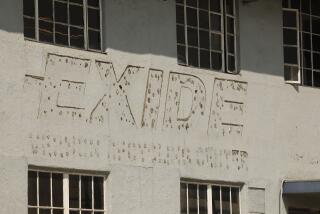Town Fights Proposal for Superfund Site : Environment: EPA wants to clean up residue of a silver and lead mine in Triumph, near Sun Valley ski area. Residents say such a program would destroy property values and damage tourism.
- Share via
TRIUMPH, Idaho — The tiny mountain community of Triumph sits nestled in a scenic glen near the ski resort of Sun Valley, about as far psychically as it is geographically from places commonly associated with toxic waste problems.
So it galled the 45 self-described aging hippies who call Triumph home when the federal Environmental Protection Agency announced in January that it would move to add a spot on the town’s outskirts to the nation’s list of Superfund sites.
The EPA says 1 million cubic yards of black sand left over from a defunct silver and lead mine constitutes a health hazard because it is laced with lead, arsenic and zinc.
The folks in Triumph--home of world-class skier Picabo Street--say the Superfund program itself poses more of a hazard to their community than the tailing left from a century of mining. The mine closed in 1957.
They say the stigma of a Superfund designation would destroy property values, hinder efforts to cash in on Triumph’s proximity to Sun Valley with new development and shatter the peace of mind that some residents moved here to find.
By one estimate, it could take 15 years to cart the waste away in an endless caravan of unwelcome trucks.
“There is no evidence at all, to the best science they have been able to show us, that we have a threat,” said Wendy Collins, one of the people fighting Triumph’s designation as a priority cleanup site.
People like Collins argue that the unheated lead in tailing remains intact and harmlessly passes through the human body, explaining why miners can work around lead for generations without widespread poisoning.
Residents also cite government tests of blood and urine samples that show lead and arsenic levels below the national average.
The EPA counters with tests showing high levels of heavy metal in the community’s drinking water. Residents doubt the accuracy of those tests.
Idaho’s best-known Superfund site is the Bunker Hill mine and smelter complex, where smokestacks spewed heated lead over northern Idaho’s Silver Valley for nearly a century.
Some people have a theory about why Triumph was picked as a cleanup priority from among about 9,000 mining sites throughout Idaho. They allege that the government is using high-profile areas such as Triumph to draw attention to its cleanup efforts.
“We’re connected to a world-famous ski resort, and it will look good in someone’s portfolio that they cleaned up an area adjacent to Sun Valley,” Donna Rose said.
Rose owns seven acres that abut the 60 acres where the mine tailing sits. She had planned to subdivide and build country houses on her property, but that is on hold now.
Triumph is not the only tourist spot troubled by being labeled a toxic waste site.
Residents in Aspen, Colo., unsuccessfully fought a Superfund designation several years ago for the Smuggler Mountain Mine, an old silver and lead mine contaminated with lead and lead residue.
Federal officials have assured Triumph residents conditions are well beyond what would justify Superfund status.
“We can’t pull the site back from the process,” said Barbara McAllister, the EPA’s regional deputy hazardous waste chief in Seattle.
The agency estimates cleanup could cost anywhere from $5 million to $600 million, depending on whether officials decide to cover over the waste with soil and vegetation or cart it away.
Government officials are just beginning to compile the list of property owners they will try to make pay for the cleanup.
About one-third of the 60 acres involved are on state land, so Idaho and its taxpayers could be liable for some of the costs.
A county commissioner who was a shareholder in the mine could also be liable.
Gov. Cecil Andrus and Idaho’s congressional delegation have called on the EPA to take another long look at the issue.
But residents fear Triumph will show up as a Superfund site in the Federal Register any time now, and a sense of foreboding has settled over the valley.
“Our valley is not sacred to them,” Rose said of the EPA. “Tourists do not go to Superfund sites for vacations.”
More to Read
Sign up for Essential California
The most important California stories and recommendations in your inbox every morning.
You may occasionally receive promotional content from the Los Angeles Times.









